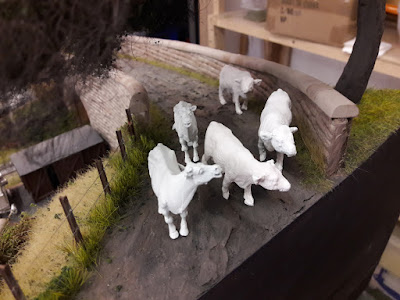Platform lamps
Water tower
Main building
Cows
Details
A full house this week. Geoff had painted the man working on the crane and added some tools. He claimed it was modelled on Laurence with hair, but Laurence seemed unimpressed.
For some weeks, Geoff has been mulling over how to convert a pair of S&D gas lamps to take 'micro' LED chips. One issue was how to get the pair of wires up to the globe.
Having exhausted more obvious solutions, he opted to make his own lamp body by turning one up in brass.
The beautifully detailed lamp fitting now has to be assembled and the LED integrated.....
Laurence completed the water tower roof, adding a ridge timber and capping strip.
He then moved on to making a new delivery pipe. First, the the old connection had to be drilled out.
The new pipe was started, using a piece of old cloth with a section on flexible plastic tube (heat-shrink) glued in the centre. This will be wrapped up and shaped in due course.
Stephen finally tackled the 'bolting-down' of the main building. The option decided upon was to glue lengths of studding into the end walls and bolt through the baseboard. A length of 4BA brass studding was sourced and two pieces cut off. First, holes were drilled down through the baseboard on the wall lines, then, with the building in place, holes were drilled up into the foam core of the walls. Once checked for fit, the studs were glued into the walls with quick-drying epoxy. Once dry, washers and nuts were fitted loosely, to be tightened up when the glue is fully set.The stairs were glued to the building together with a small timber store box to cover a timber locating block. The unpainted ground around the stairs was coated with 'Yard Filth'. Weeds and clutter will be added later.
Geoff had given the two white metal cows a coat of white primer to match the 3D printed trio. The metal ones are a bit scrawny in comparison and will probably be fattened-up with a bit of filler. Placed at the top of the bridge path, they start to fill the space (and disguise the backscene junction nicely.
Geoff had also assembled a lovely S&D kit of an Ingersoll Rand mobile generator. Once painted, it is destined for the quarry siding, near the bridge.








































